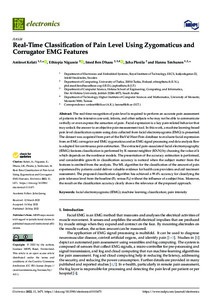Real-Time Classification of Pain Level Using Zygomaticus and Corrugator EMG Features
Kelati Amleset; Tenhunen Hannu; Ben Dhaou Imed; Plosila Juha; Nigussie Ethiopia
https://urn.fi/URN:NBN:fi-fe2022081154449
Tiivistelmä
The real-time recognition of pain level is required to perform an accurate pain assessment of patients in the intensive care unit, infants, and other subjects who may not be able to communicate verbally or even express the sensation of pain. Facial expression is a key pain-related behavior that may unlock the answer to an objective pain measurement tool. In this work, a machine learning-based pain level classification system using data collected from facial electromyograms (EMG) is presented. The dataset was acquired from part of the BioVid Heat Pain database to evaluate facial expression from an EMG corrugator and EMG zygomaticus and an EMG signal processing and data analysis flow is adapted for continuous pain estimation. The extracted pain-associated facial electromyography (fEMG) features classification is performed by K-nearest neighbor (KNN) by choosing the value of k which depends on the nonlinear models. The presentation of the accuracy estimation is performed, and considerable growth in classification accuracy is noticed when the subject matter from the features is omitted from the analysis. The ML algorithm for the classification of the amount of pain experienced by patients could deliver valuable evidence for health care providers and aid treatment assessment. The proposed classification algorithm has achieved a 99.4% accuracy for classifying the pain tolerance level from the baseline (P0 versus P4) without the influence of a subject bias. Moreover, the result on the classification accuracy clearly shows the relevance of the proposed approach.
Kokoelmat
- Rinnakkaistallenteet [19207]
